Origins of Billiards
Days of Old No. 1 - June 1982
The Origin of Billiards
(Some pictures have been added to Norman's original article to ,
we hope, help and expand on his words)
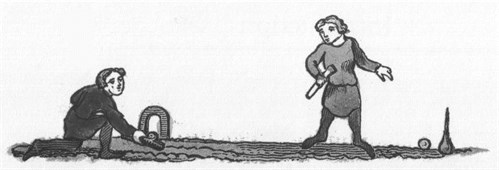
A form of billiards played on
the ground in the 1300's.
Taken from Strutts 'The Sports
and pastimes of the people of England'
The origin of the game of Billiards is
very obscure, although many efforts have been made to trace its
history, always without success. There are in existence a number of
'theories' or 'anecdotes' which endeavour to explain the origin of
the game and the reader must choose whichever 'story' they prefer.
One thing, however, is absolutely definite, it is an extremely old
game which has gradually developed so that the present day game is
completely unrecognisable from the original.
It is said by some writers that a game similar to Billiards was
seen by a traveller called Anacharsis in Ancient Greece some 400
years BC. We certainly have proof that Billiards was played during
the reign of Elizabeth I as Shakespeare in the play 'Anthony &
Cleopatra' has the Queen say to her maid - 'come Charmain, let us
to Billiards. (Note, however whilst this certainly indicates that
Shakespeare was acquainted with the game, it does not mean that it
was known in ancient Egypt).
It is accepted that the game was originally played on the ground
outdoors and it is related to the game of croquet. This theory is
supported by early illustrations and pictures, showing hoops and
also post (similar to croquet) on the surface of the Billiards
Table (see illustrations) and that from the lawn it was brought
indoors and for convenience raised to table height.
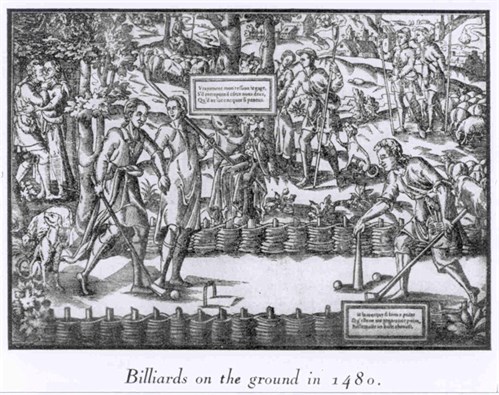
This etching is taken from the
tapestry commissioned by monastery of St.Lo.
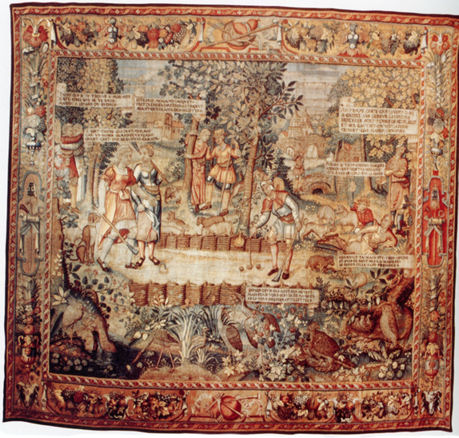
(Above is the actual St. Lo
tapestry. More information about the tapestry can be found in 'The
Billiard Encyclopaedia' by Stein & Rubino)
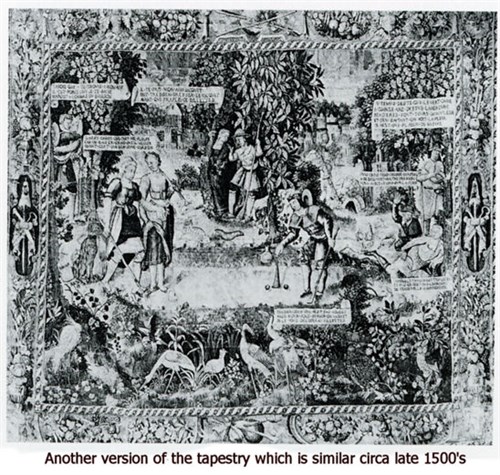
(From 'The Billiard
Encyclopaedia' by Stein & Rubino)
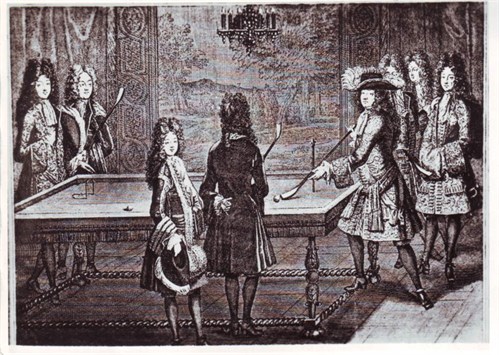
Louis XIV at Billiards in 1694;
The King is 'playing the ball'
The engraving is displayed at
'Le Bibliotheque Nationale' Paris
You can clearly see the
similarities between the etching of 'Billiards on the Ground' and
the on showing Louis XVI playing Billiards. Even the maces (used to
propel the balls) are similar in shape along with the the hoop and
pin
One 'story' explaining how the game came to be called
'Billiards' relates to how a 'Pawnbroker' by the name of William
Kew (!), who, after closing the shop, used to take down the three
brass balls of his sign and used them to play in the yard behind
his shop - his friends used to join him, saying they were going to
play in Bill's Yard!! Maybe his name also explains why the
instrument we use to propel the balls is called a 'Cue'!!.
Two different forms of the game developed - in most European
Countries Billiards is played on a table without pockets -(and so
unfortunately they cannot play the more recently developed game of
Snooker. - This of course changed in the late 1980's
when , with the help of Pot Black and other televised UK
tournaments, Snooker proved to be popular especially in Belgium
& Holland with the UK firms supplying the suitable
tables)[Snooker being a game invented to be played on a British
Billiards Table as in the 'Origins of
Snooker' article] - whilst the British
Billiards Table as we all know has six pockets. One result of this
difference is that wherever in the world British emigrants and
colonists settled and established themselves they took with them
the British version of the game. Whilst the European settlers
(French, Spanish and Dutch) introduced the continental game of
Billiards to their colonies and this is the game played in their
sphere of influence. It is perhaps interesting to note that it was
the Spaniards who took the game to what is now the U.S.A. By
introducing Billiards to St. Augusta, Florida in 1565. So to this
day, if you play Billiards in the U.S.A. It is the Continental game
and every year American players take part in the 'World 3 Cushion
Billiards Championships'. It is also the rules of this game of
Billiards which are published in the hand book of 'The Billiard
Congress of America' and they do not play the British game. (Note -
in the U.S.A. the various games of 'Pool' are played on a 'Pocket
Billiards' Table so called to distinguish it from a 'Billiards'
table without pockets which in Europe is known as a Carom
table).
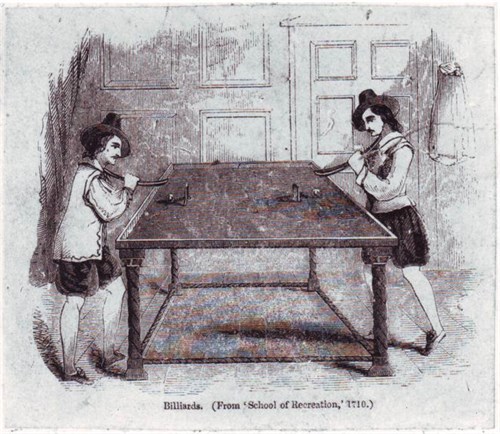
Billiards - from 'school of
Recreation, 1710

Mozart (1756 -91) at his
Billiards Table
again note the hoop and lack of
cushioning on the table surround.
When the game was first brought
indoors and raised to table height (as you will see from the
illustration 'Billiards', from the 'School of Recreation' 1710) a
plain wooden rim without any form of cushioning surrounded the
table to prevent the balls falling on the floor. The tables were of
lightweight construction. Maces (early form of Cue) were used to
propel the balls. The balls themselves were also originally made of
wood. There were no properly established rules and the dimensions
of the Billiards Table itself, the size of the balls and the pocket
openings etc., all varied. In this respect it is interesting to
note that an old rule book printed in 1779 allowed the player to
use the point of the cue or the butt of the cue!
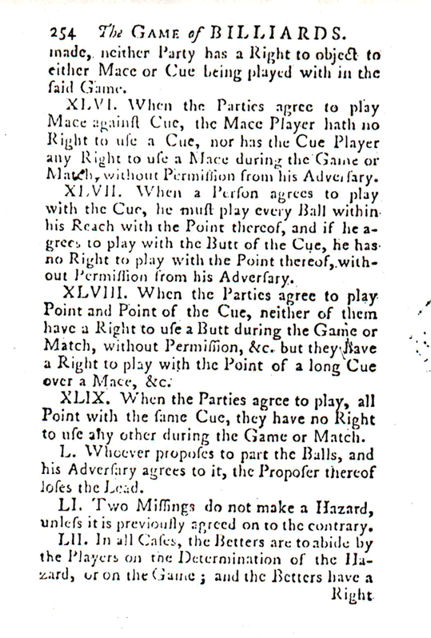
But more of that next time -
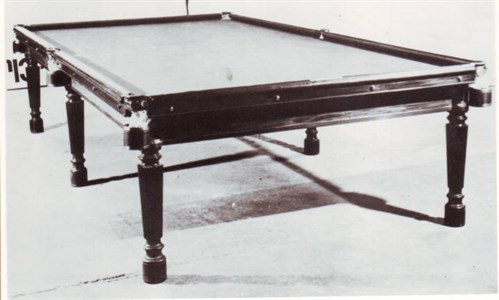
early 19th Century Gillow
Billiards Table with wood bed table - light weight frame
*********************
© Norman Clare 1990. © E.A.
Clare & Son Ltd. 2018.
Reproduction of this article allowed only with the permission from
E.A. Clare & Son Ltd.
Please do not hesitate to ask should need any advice on snooker,
billiards or pool or wish to make a purchase. Thurston has the most
comprehensive range of tables and accessories available.
Visit our e-shop - www.thurston.co.uk
email - thurston@eaclare.co.uk
Phone - 0151 482 2700

